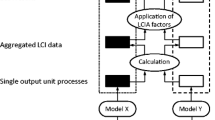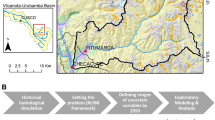Abstract
Environmental decision support systems (EDSSs) are an emerging tool used to integrate the evaluation of highly complex and interrelated physicochemical, biological, hydrological, social, and economic aspects of environmental problems. An EDSS approach is developed to address hot-spot concerns for a water quality trading program intended to implement the total maximum daily load (TMDL) for phosphorus in the Non-Tidal Passaic River Basin of New Jersey. Twenty-two wastewater treatment plants (WWTPs) spread throughout the watershed are considered the major sources of phosphorus loading to the river system. Periodic surface water diversions to a major reservoir from the confluence of two key tributaries alter the natural hydrology of the watershed and must be considered in the development of a trading framework that ensures protection of water quality. An EDSS is applied that enables the selection of a water quality trading framework that protects the watershed from phosphorus-induced hot spots. The EDSS employs Simon’s (1960) three stages of the decision-making process: intelligence, design, and choice. The identification of two potential hot spots and three diversion scenarios enables the delineation of three management areas for buying and selling of phosphorus credits among WWTPs. The result shows that the most conservative option entails consideration of two possible diversion scenarios, and trading between management areas is restricted accordingly. The method described here is believed to be the first application of an EDSS to a water quality trading program that explicitly accounts for surface water diversions.







Similar content being viewed by others
References
Cortes U, Sanchez-Marre M, Ceccaroni L, Roda IR, Poch M (2000) Artificial intelligence and environmental decision support systems. Artificial Intelligence 13:77–91
Chen CW, Herr J, Weintraub L (2004) Decision support system for stakeholder involvement. Journal of Environmental Engineering 130(6):714–721
Chen CW, Herr J, Ziemelis L, Goldstein RA, Olmsted L (1999) Decision Support System for Total Maximum Daily Load. Journal of Environmental Engineering 125(7):653–659
Demissie M, Tidrick M (2001) The Illinois River Decision Support System (ILRDSS). American Water Resource Association Proceedings for Decision Support Systems for Water Resources Management. Snowbird, UT, pp 7–12
Doherty J, Johnston JM (2003) Methodologies for calibration and predictive analysis of a watershed model. Journal of the American Water Resources Association 39(2):251–265
Druzdzel MJ, Flynn RR (1999) Decision support systems. In: Encyclopedia of library and information science. A. Kent/Marcel Dekker, New York
Fassio A, Giupponi C, Hiederer R, Simota C (2005) A decision support tool for simulating the effects of alternative policies affecting water resources: an application at the European scale. Journal of Hydrology 304:462–476
Fedra K (1993) GIS and environmental modeling. In: Goodchild MF, Parks BO, Steyaert LT (eds) Environmental modeling with GIS. Oxford University Press, New York
Funtowicz SO, Ravetz JR (1999) Post-normal science: an insight now maturing. Futures 31(7):641–646
Guariso G, Werthner H (1989) Environmental decision support systems. Ellis Horwood/Wiley, New York
Janssen R, Goosen H, Verhoeven ML, Verhoeven JTA, Omtzigt AQA, Maltby E (2005) Decision support for integrated wetland management. Environmental Modeling & Software 20:215–229
Lukasheh AF, Droste RL, Wraith MA (2001) Review of expert system (ES), geographic information system (GIS), decision support system (DSS), and their applications in landfill design and management. Waste Management & Research 19:177–185
Najarian Associates, Inc. (2005) Project Report: Development of a TMDL for the Wanaque Reservoir and cumulative WLAs/LAs for the Passaic River Watershed. Submitted to NJDEP Division of Watershed Management, Trenton, NJ. Available from http://www.state.nj.us/dep/watershedmgt/DOCS/Final%20Report%207-1-05.pdf (accessed 15 September 2006)
NJDEP (New Jersey Department of Environmental Protection) (2004) Integrated water quality monitoring and assessment report (305(b) and 303(d)). Water Assessment Team, Trenton, NJ
NJDEP (New Jersey Department of Environmental Protection) (2007) Total maximum daily load report for the Non-Tidal Passaic River Basin addressing phosphorus impairments—PROPOSED. Division of Watershed Management, Trenton, NJ
NJDWSC (North Jersey District Water Supply Commission) (2002a) Watershed characterization and assessment, a technical report for the Passaic River Basin Watershed Management Project. Watershed Management Area 3: Pompton, Pequannock, Wanaque, and Ramapo River Watersheds. Available from http://njedl.rutgers.edu/ftp/html/2909/index.html
NJDWSC (North Jersey District Water Supply Commission) (2002b) Watershed characterization and assessment, a technical report for the Passaic River Basin Watershed Management Project. Watershed Management Area 4: Lower Passaic and Saddle River Watersheds. Available from http://njedl.rutgers.edu/ftp/html/2910/index.html
NJDWSC (North Jersey District Water Supply Commission) (2002c) Watershed characterization and assessment, a technical report for the Passaic River Basin Watershed Management Project. Watershed Management Area 6: Upper Passaic, Whippany, and Rockaway River Watersheds. Available from http://njedl.rutgers.edu/ftp/html/2911/index.html
Omni Environmental Corporation (2007a) The Non-Tidal Passaic River Basin nutrient TMDL study Phase II watershed model and TMDL calculations: Final report. Omni Environmental Corporation, Princeton, NJ
Omni Environmental Corporation (2007b) Evaluation of phosphorus trading scenarios for the Non-Tidal Passaic River Basin nutrient TMDL. Omni Environmental Corporation, Princenton, NJ
Poch M, Comas J, Rodriguez-Roda I, Sanchez-Marre M, Cortes U (2004) Designing and building real environmental decision support systems. Environmental Modelling & Software 19:857–873
Rauch W, Bertrand-Krajewski J-L, Krebs P et al (2002) Deterministic modelling of integrated urban drainage systems. Water Science and Technology 45(3):81–94
Rizzoli AE, Young WJ (1997) Delivering environmental decision support systems: software tools and techniques. Environmental Modelling & Software 12(2–3):237–249
Sarang A, Baradarannia MR, Lence BJ, Shamsai A (2006) System dynamics application for analyzing adaptive urban water management policies in Tehran. Adaptive Management of Water Resources AWRA Summer Specialty Conference, Missoula, MT
Simon HA (1960) The new science of management decision. Harper & Row, New York
Thill JC (1999) Spatial multicriteria decision making and analysis: a geographic information science approach. Ashgate Publishing, Aldershot, UK
U.S. Census Bureau (2002) Census 2000 data for the State of New Jersey. Available from http://www.census.gov/census2000/states/nj.html (accessed 15 December 2005)
USEPA (United States Environmental Protection Agency) (2004) Water quality trading assessment handbook. Technical Report EPA 841-B-04-001. Office of Water, Washington DC
USEPA (United States Environmental Protection Agency) (2003) Final water quality trading policy. Available from http://www.epa.gov/owow/watershed/trading/finalpolicy2003.pdf (accessed December 2006)
Acknowledgments
This research was funded by US EPA Targeted Watershed Grant Agreement No. WS97284104-0. The authors are grateful to two reviewers for their insightful comments, as well as to Dr. Richard Boisvert, Dr. William Goldfarb, Dr. Gregory Poe, Dr. Peter Strom, Dr. Christopher Uchrin, Jeffrey Potent, Yukako Sado, and Lisa Galloway Evrard for their contributions to the development of the Non-Tidal Passaic River Basin water quality trading program. In addition, the authors would like to thank USEPA Region 2 and the New Jersey Department of Environmental Protection. The research described in this paper has been funded by the United States Environmental Protection Agency (EPA) under the Targeted Watershed Grant Program and the Science to Achieve Results (STAR) Graduate Fellowship Program. EPA has not officially endorsed this publication and the views expressed herein may not reflect the views of the EPA.
Author information
Authors and Affiliations
Corresponding author
Rights and permissions
About this article
Cite this article
Obropta, C.C., Niazi, M. & Kardos, J.S. Application of an Environmental Decision Support System to a Water Quality Trading Program Affected by Surface Water Diversions. Environmental Management 42, 946–956 (2008). https://doi.org/10.1007/s00267-008-9153-z
Received:
Revised:
Accepted:
Published:
Issue Date:
DOI: https://doi.org/10.1007/s00267-008-9153-z




